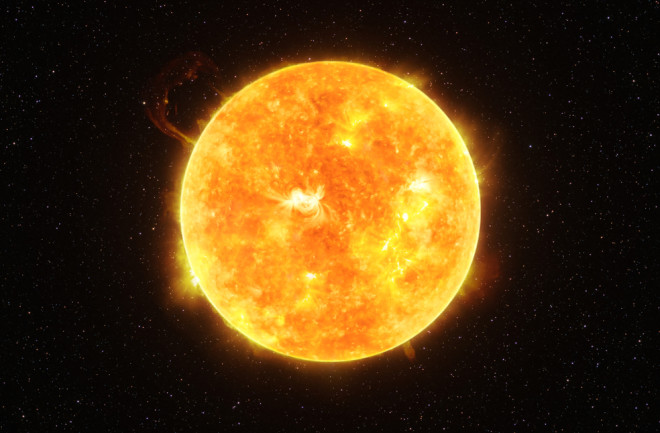Back in the late 1960s, the British astrophysicist Donald Lyndon-Bell deduced that most galaxies must have a supermassive black hole at their hearts. Since then much evidence has emerged to support this idea. In 2018, astronomers even took an image of the black hole sitting at the center of a nearby galaxy called M87.
It turns out that supermassive black holes play a crucial role in the evolution of galaxies by creating the gravitational field that binds stars together. They also swallow nearby dust and gas creating massive jets of energy that themselves create conditions ripe for star formation.
The supermassive black hole at the center of our galaxy has a mass equivalent to about a million suns and a radius about the diameter of Mercury’s orbit around the sun.
But black holes can be much smaller. A black hole with the mass of our Sun would be a few kilometers in size while a black hole with the mass of an asteroid would be the size of a single atom.
There are good reasons to think that black holes in this size range must have been formed early in the universe and that these primordial black still fill the universe.
And that raises an interesting question. If supermassive black holes seed the formation of galaxies, could smaller black holes seed the formation of stars? Could a black hole even sit at the center of our Sun?
Hawking Stars
Now we have an answer thanks to the work of Matthew Caplan at Illinois State University, and colleagues, who calculated the properties that stars would have if they formed in this way. Their conclusion is, yes, it is possible that a black hole sits at the center of our nearest star. But the situation is complex.
Astronomers have suggested for some time that stars may have black holes at their centers. In the 1970s, for example, they discovered that the Sun did not appear to be generating enough neutrinos to match the fusion energy it produced. (Neutrinos are by-products of fusion reactions).
That suggested some of the Sun’s energy must be produced in a different way. Stephen Hawking put forward the idea that all could be explained if the Sun housed a central back hole. In that case, matter falling into this black hole would generate enough energy to make up the difference without producing neutrinos.
The problem was eventually solved by the discovery of neutrino oscillations — that neutrinos rapidly change character as they move through the universe. The oscillations sometimes make them difficult to detect and this leads to the deficit. So the black hole idea was forgotten.
More recently, astronomers have begun to think that primordial black holes may make up much of the missing mass of the universe, the so-called dark matter. This is mass that astronomers can detect by its gravitational effect on visible matter, but cannot see.
Primordial black holes can exist in sizes ranging from asteroid mass to stellar mass. And if they are plentiful, interactions with ordinary matter must be common.
Indeed, one possibility is that black holes seed the formation stars, or at least are present as stars form. The big question that Caplan and co-investigate is how the presence of a black hole would influence the evolution of a star and whether this would be observable. “Ultimately, the evolution is highly sensitive to the accretion physics,” say Caplan and co in a paper from which the title of this blog post is taken.
They begin by calculating the property of a star with a low mass asteroid-sized black hole at its center. The atomic size of such a black hole makes interactions with matter much less likely than with larger black holes and this has a significant influence on the star’s evolution. “Stars with very low mass primordial black holes could be very long lived with many surviving their entire main sequence phase,” they say.
Larger black holes lead to much more complex behavior, in which the black holes grows rapidly by accretion, eventually eating the entire star.
But even that needn’t mean this process is unlikely. Caplan and co suggest it would lead to a new class of black holes with a mass less than that of our sun. That’s interesting because until now, astronomers had thought black holes of this size could not exist because there is no mechanism to produce them.
Indeed, the team suggest that it could be common for stars to have black holes at their hearts. “As a central black hole does not significantly modify the early phases of evolution, we suggest that many main sequence stars could be harboring central black holes,” they say.
And that includes our Sun.
Planetary Games
The bigger picture here is that if primordial black holes are much more common than previously thought, then they could be the dark matter that astronomers have been looking for. And the evidence could come by looking in more detail at the properties of stars we already know well.
That work is now likely to start in earnest, along with more detailed simulations of exactly how to tell the difference between a star with an internal black hole and one without. Astroseismology — the way sound travels through the star — seems to be key. And the most obvious target for future work is our Sun.
Beyond that, other ideas come thick and fast. If black holes have played a role in the formation of galaxies and stars, could they also play a role in other accretion processes such as the formation of planets? Could there be, or have been, a low mass black hole at the centre of the Earth? Now there’s a question likely to trigger some angry debate. Lyndon-Bell, who died in 2018, would surely have been amused.
Ref: Is there a black hole in the center of the Sun? : arxiv.org/abs/2312.07647

